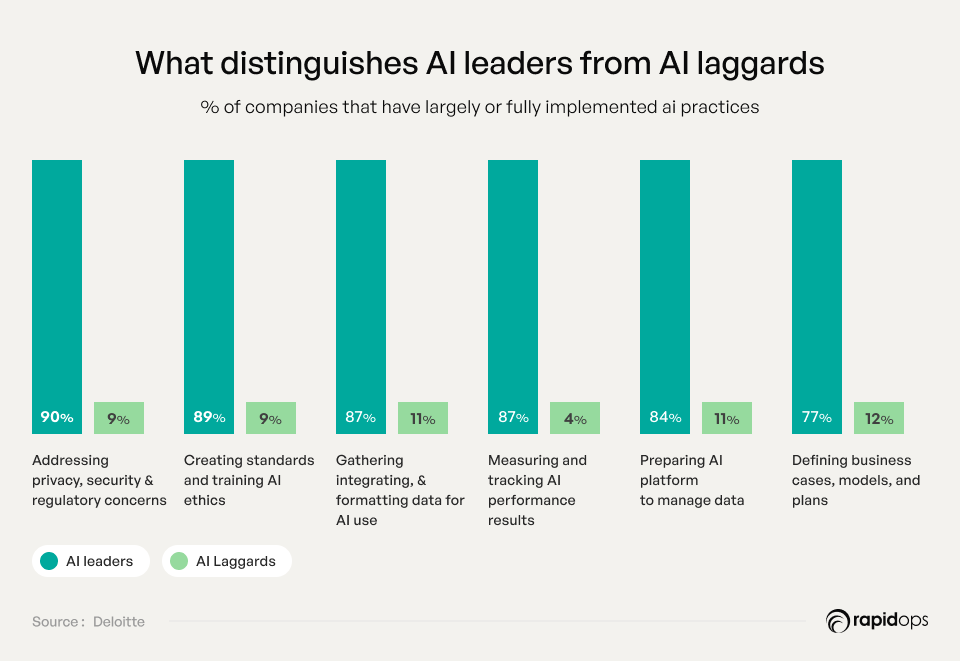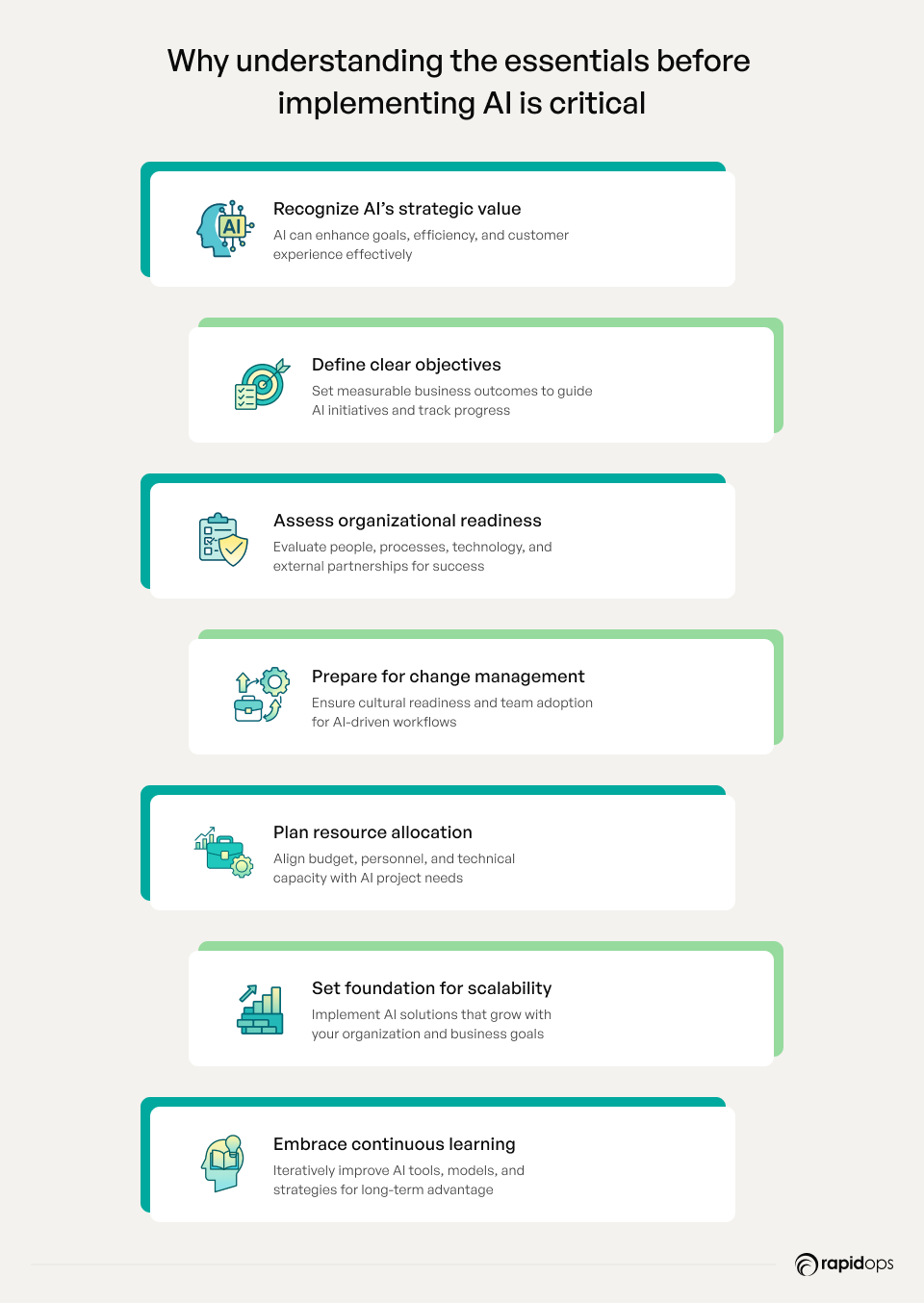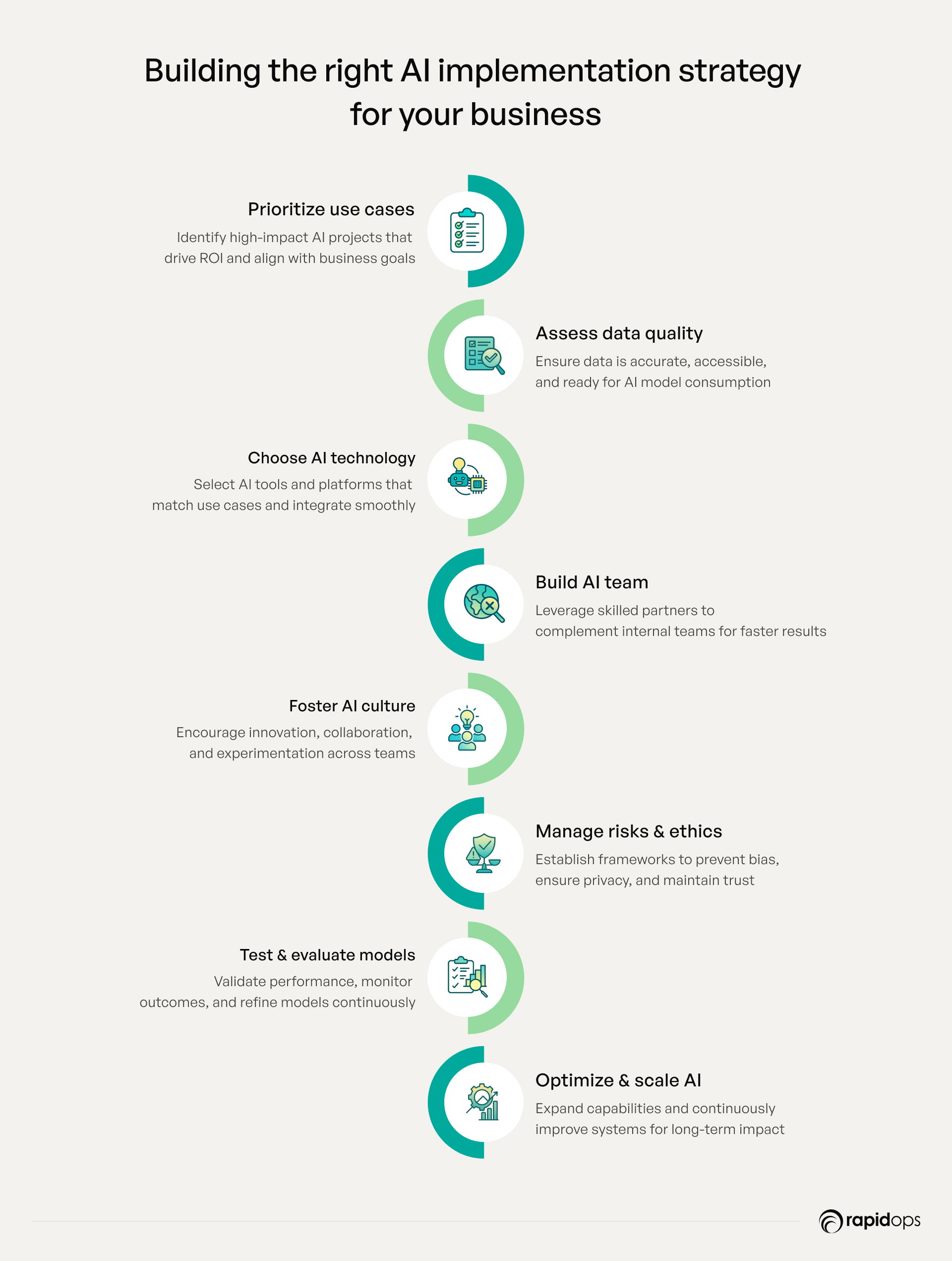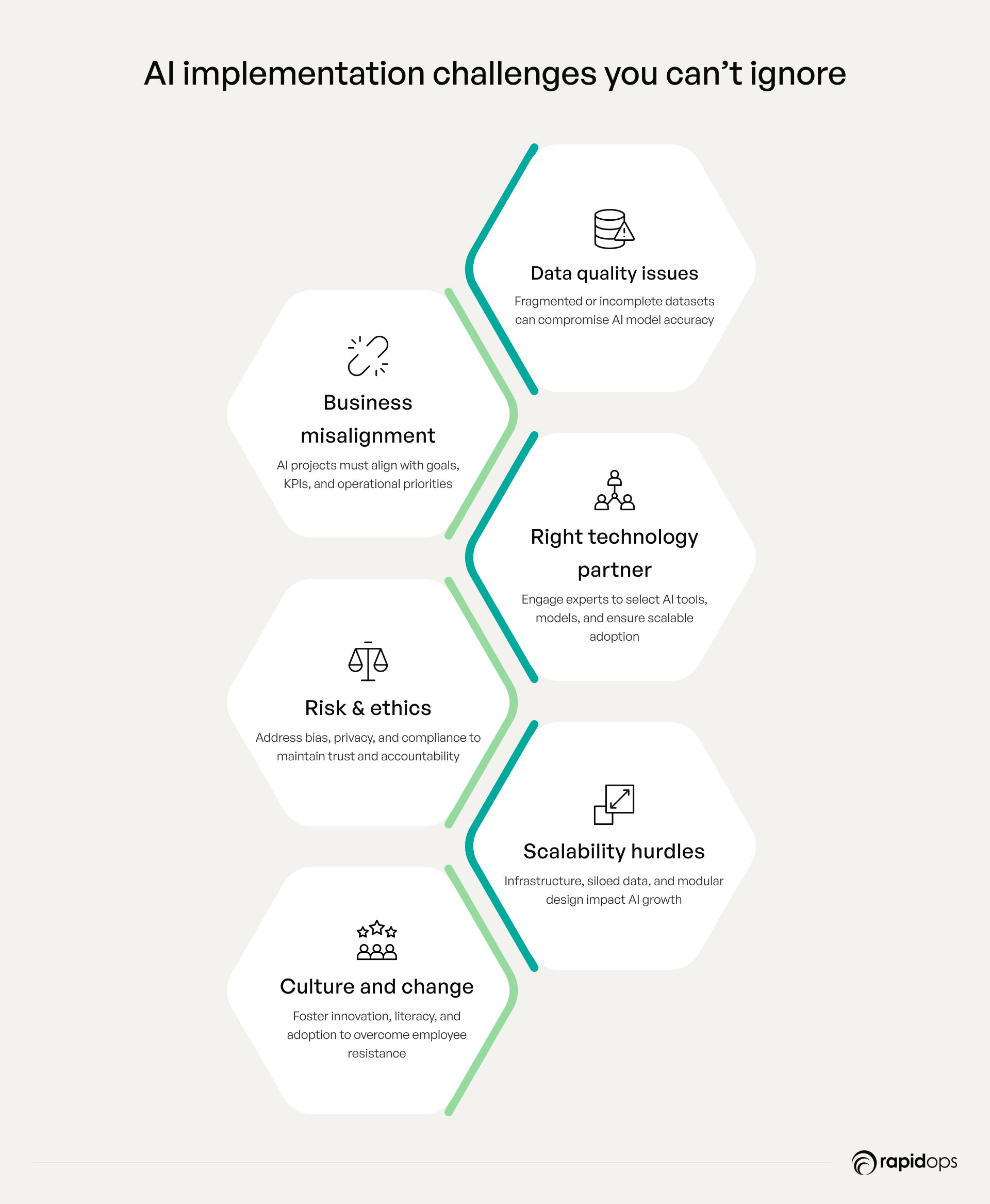After the internet transformed business as we knew it, Artificial Intelligence has emerged as the force reshaping how organizations think, make decisions, and deliver measurable impact. Yet for many executives, AI’s promise often clashes with the realities of execution. Take a leading retailer: months into an AI initiative aimed at personalizing customer experiences, progress stalled, priorities were scattered, data was fragmented, and teams weren’t prepared to act on insights. The result? Significant investment, limited outcomes, and stalled momentum.
For leaders taking their first steps into AI or expanding early wins across critical business functions, the challenge isn’t technology. It’s knowing what to automate, identifying high-impact use cases, aligning initiatives with strategic objectives, and building organizational readiness to act decisively on AI-driven insights. Studies confirm the stakes: 95% of AI pilots fail to deliver meaningful outcomes, and 85% of failures arise from strategic misalignment, not technical limitations.
Success demands a structured, outcome-driven approach. Executives must define clear priorities, uncover transformative AI opportunities, build adaptable data and technology infrastructure, and cultivate teams capable of trusting and acting on insights. When executed thoughtfully, AI evolves from a project into a strategic capability that optimizes operations, elevates customer experiences, and drives measurable business advantage.
This article shares proven strategies and actionable insights to help executives bridge the gap between AI intent and execution. Whether starting your first initiative or extending early successes across the organization, these principles will guide you in turning AI into a core driver of strategic advantage and measurable impact.

Why do few organizations succeed in AI implementation and value scaling
While AI adoption continues to rise, many organizations struggle to translate it into measurable business value. A 2025 report by Boston Consulting Group (BCG) reveals that only 5% of over 1,250 global companies studied are achieving real returns on AI investments, such as revenue growth, cost reductions, and improved workflows. In contrast, 60% have realized little to no benefit, reporting only minimal increases in revenue and cost savings despite making substantial investments. Business Insider
This disparity often stems from a lack of strategic planning, skilled personnel, and robust technology infrastructure. Organizations that achieve real impact approach AI strategically from day one. Leaders combine clear objectives with robust AI systems, aligning initiatives with overarching business goals and operational processes. PwC highlights that successful AI adopters pursue a holistic approach, simultaneously driving business transformation, modernizing systems, and enhancing decision-making.
Ultimately, integrating AI effectively positions companies as industry frontrunners. Yet, success requires more than technology; it demands deliberate planning, cross-functional collaboration, and disciplined execution. By following proven frameworks and learning from AI leaders' experiences, businesses can scale AI initiatives, unlock value, and turn high-potential projects into measurable, long-term results.
Why understanding the essentials before implementing AI is critical
Before you begin implementing AI in your organization, it is essential to understand the foundational elements that determine whether your initiatives will succeed. AI is not just a technology upgrade; it is a transformative capability that can reshape your business strategy, operations, and decision-making. Without a clear grasp of the essentials, even the most advanced AI systems, AI models, and AI solutions may fail to deliver measurable value.

Recognizing the strategic value of AI
AI is more than a set of tools; it is a strategic asset that can enhance business goals, operational efficiency, and customer experiences. By understanding the potential of AI initiatives and AI capabilities, you can ensure that every effort aligns with your organizational objectives and drives real business impact. This perspective helps you make informed choices about AI adoption and AI deployment.
Define clear objectives and expected outcomes
Before implementing AI, clearly define your business objectives and expected outcomes. Whether your goal is to enhance, optimize processes, or improve decision-making, clarity enables you to measure progress, identify gaps, and adjust strategies proactively. Establishing clear outcomes ensures that AI projects deliver tangible results aligned with your strategic goals.
Assess organizational readiness
Successful AI adoption depends on your organization’s preparedness across people, processes, and technology. Beyond internal expertise, partnering with experienced technology providers can ensure teams manage AI models, tools, and systems effectively. Readiness also involves evaluating data quality, input standards, and regulatory compliance. By combining internal capabilities with strategic external support, organizations can deploy AI responsibly, efficiently, and in alignment with business objectives.
Prepare for cultural and change management needs
AI adoption is as much about people as it is about technology. You need to ensure your teams are ready to embrace new technologies, AI-driven workflows, and AI innovation. Preparing your organization culturally and operationally fosters acceptance, collaboration, and long-term sustainability of AI initiatives.
Plan resource allocation and capacity
Understanding the resources, budget, personnel, and technical capacity required is critical. Thoughtful planning ensures your AI initiatives are feasible, scalable, and capable of delivering consistent, valuable insights. This preparation enables the smooth execution of AI projects and optimizes the impact of AI deployment.
Set the foundation for scalability
AI is not a one-time project; it’s a capability that grows with your organization. To scale effectively across functions and evolving business needs, partnering with experienced technology providers ensures solutions deliver sustained impact, continuous improvement, and outcomes that internal teams alone may struggle to achieve.
Adopt a mindset of continuous learning and feedback
Finally, understanding the essentials means embracing iterative improvement and adaptive strategies. By cultivating a mindset of constant learning, you can refine AI models, AI tools, and AI projects over time, ensuring your organization gains a long-term competitive advantage and consistently leverages AI to generate valuable insights.
By understanding these essentials, you equip your organization to implement AI effectively, maximize ROI, and achieve measurable business impact. This foundational knowledge prepares you to approach the step-by-step implementation with confidence, ensuring every action is informed, strategic, and aligned with your business objectives.
Crafting an AI implementation strategy: A step-by-step guide
Building a successful AI implementation strategy isn’t about complexity; it’s about clarity. Think of it as constructing a house. Without a blueprint, even the best materials won’t lead to a stable structure. This step-by-step guide will help you lay a strong foundation, ensuring your AI initiatives deliver real, measurable results.

Step 1: Prioritize high-impact use cases
Once your AI objectives are defined, the next critical step is to identify and prioritize high-impact use cases that will deliver measurable value to your organization. Not all AI opportunities are equal, focusing on initiatives that directly influence business goals, operational efficiency, and customer outcomes ensures your investment drives meaningful impact. Evaluate potential use cases based on feasibility, data availability, and alignment with strategic priorities.
Start by analyzing business processes where AI systems, AI models, or Gen AI tools can automate repetitive tasks, enhance decision-making, or generate valuable insights. Examples include predictive maintenance to reduce operational downtime, AI-driven customer service automation to boost satisfaction, or machine learning models to optimize inventory management. Rank these opportunities based on potential ROI, scalability, and ease of integration within existing business processes.
Engaging a technology partner or AI consultancy can further strengthen this step. They bring industry expertise, advanced AI knowledge, and a fresh perspective, helping you uncover high-value opportunities you might overlook internally. A skilled partner can also guide you in assessing technical feasibility and aligning use cases with long-term strategic objectives.
Prioritizing high-impact use cases ensures your AI adoption efforts focus on initiatives that are achievable, measurable, and strategically aligned. By balancing business value with technical feasibility, you create a clear path to successful AI deployment, setting the stage for subsequent steps such as assessing data quality and selecting the right AI technologies.
Step 2: Assess data quality and accessibility
With high-impact AI use cases identified, the next step is to ensure your organization has reliable, accessible, and high-quality data to power your initiatives. Even the most advanced AI systems cannot deliver value without accurate, complete, and consistent input data. Start by auditing datasets across key business functions, from customer interactions and inventory management to operational workflows, to verify they are up to date, representative of real-world scenarios, and aligned with your business objectives.
Accessibility is equally critical. Data must be structured, machine-readable, and integrated across departments to enable smooth ingestion into AI models, predictive systems, or machine learning algorithms. Compliance with data privacy regulations, such as GDPR or CCPA, and robust security protocols are essential to safeguard sensitive information.
For many organizations, achieving this level of readiness internally can be challenging due to resource constraints or a lack of specialized expertise. Partnering with a technology expert can accelerate the process, helping with audit data, setting up pipelines, implementing storage solutions, and ensuring your AI initiatives are scalable and aligned with strategic goals.
High-quality, accessible data empowers better decision-making, actionable insights, and measurable business outcomes. By leveraging a technology partner, organizations reduce risk, prevent bias, and lay a strong foundation for selecting the right AI technologies and executing successful AI projects.
Step 3: Choose the right AI technology
With high-quality, accessible data in place, the next critical step is selecting the AI technologies and tools that best align with your prioritized use cases and business objectives. Executives rarely have the bandwidth or technical depth to evaluate every solution, this is where a trusted technology partner becomes essential. A skilled partner can guide you in choosing AI systems, AI models, and tools that deliver measurable impact while integrating seamlessly with existing business processes.
Start by identifying the capabilities required for each use case. Machine learning models excel at predictive analytics and operational forecasting; NLP tools automate customer interactions and generate insights from unstructured data; and computer vision frameworks improve quality control, inventory tracking, and product recognition. A technology partner can assess whether open-source libraries, cloud platforms, or proprietary solutions best meet your scalability, compliance, and innovation needs.
Infrastructure and compatibility should also drive technology selection. Ensure platforms integrate smoothly with your data pipelines, deployment environment, and existing tech stack to enable efficient model training and evaluation. With expert guidance, executives can avoid costly missteps and accelerate AI adoption.
By leveraging a technology partner, organizations maximize the effectiveness of AI initiatives, achieve faster ROI, and position their teams for continuous improvement, innovation, and long-term competitive advantage.
Step 4: Build an AI-proficient team
After selecting the right AI technologies, the success of your initiative depends on having the right expertise, but building a fully in-house AI team is often impractical. Instead, organizations can achieve faster impact and greater cost efficiency by partnering with specialized AI teams or technology partners. These experts bring technical proficiency, business insight, and implementation experience, ensuring AI initiatives deliver measurable results without the long lead times of internal hiring and upskilling.
A specialist partner can provide access to data scientists, machine learning engineers, software developers, and domain experts, all aligned with your business objectives. They help develop, deploy, and integrate AI models while maintaining compliance with regulatory and ethical standards. This approach also allows your internal teams to focus on strategic priorities and business integration rather than being overwhelmed by technical execution.
For organizations with long-term AI programs and sufficient budgets, selectively hiring key internal roles, such as AI program managers or business-domain experts, can complement the partner team. However, for development, deployment, and scaling, a trusted technology partner ensures speed, expertise, and operational continuity.
By leveraging strategic partnerships, companies can accelerate AI adoption, transform insights into actionable outcomes, and build a scalable, sustainable capability that drives efficiency, innovation, and competitive advantage all without the risk and overhead of assembling a fully internal team from scratch.
Step 5: Foster a culture of AI innovation
Building a proficient AI team is only part of the equation; fostering a culture of innovation ensures that AI initiatives are embraced, scaled, and continuously improved. Organizations that encourage experimentation, creativity, and proactive problem-solving are far more likely to achieve successful AI implementation and extract meaningful value from AI systems.
Leadership plays a pivotal role in establishing this culture. Clear communication of the AI customer strategy, its potential to optimize business processes, and alignment with business objectives inspire teams to explore novel AI applications. Encouraging small-scale pilot projects provides a safe environment to test AI models, refine approaches, and learn from outcomes before full-scale deployment.
Cross-functional collaboration strengthens this culture. When data scientists, machine learning engineers, domain experts, and business stakeholders collaborate, AI insights are directly tied to real-world impact, fostering confidence in AI adoption across departments. Recognizing successes, sharing learnings, and incentivizing innovation motivate teams to continuously seek improvements and leverage generative AI (Gen AI) tools effectively.
Embedding AI into the organizational mindset transforms it from a technology initiative into a strategic capability, enabling the company to respond to evolving market demands, make data-driven decisions, and sustain competitive advantage. A culture of AI innovation ensures that your AI initiatives remain relevant, adaptable, and impactful over the long term.
Step 6: Manage risks and build ethical frameworks
Even with the right team and a culture of innovation, AI initiatives carry inherent risks. From data privacy concerns to model bias, security vulnerabilities, and unintended consequences, unmitigated risks can derail adoption and damage stakeholder trust. Organizations must proactively establish a risk management strategy alongside an ethical framework to safeguard AI deployment and ensure responsible usage.
Start by conducting comprehensive risk assessments to evaluate where AI models could fail, introduce bias, or inadvertently impact decision-making processes. Implement robust data governance practices, including anonymization, encryption, and access controls, to protect sensitive information and comply with regulations such as GDPR and CCPA. Regular testing of AI models ensures outputs remain accurate, fair, and aligned with business objectives.
An ethical framework codifies principles such as transparency, accountability, fairness, and respect for user autonomy. Establishing an AI ethics committee or review board helps oversee projects, assess potential societal impacts, and maintain adherence to both legal standards and organizational values. By embedding ethics into the AI adoption process, organizations not only mitigate risk but also foster trust with customers, employees, and stakeholders.
Integrating risk management and ethical guidelines ensures that AI is not only a strategic tool for business growth but also a responsible and sustainable capability that delivers long-term value, innovation, and competitive advantage.
Step 7: Test and evaluate models
Even the most sophisticated AI models require rigorous testing and evaluation to ensure they deliver reliable insights and business value. Before deployment, organizations must validate that AI systems perform accurately, generalize effectively to new data, and align with strategic objectives. This transforms AI initiatives from theoretical capabilities into practical, actionable tools.
Begin by using separate validation and test datasets to assess performance metrics such as accuracy, precision, recall, and F1 score, depending on the specific AI model and its business application. Evaluating the model for potential bias or systematic errors ensures fairness and prevents unintended consequences in decision-making. Structured testing minimizes risk while reinforcing stakeholders' trust in Gen AI solutions.
Continuous evaluation is equally critical. As real-world data evolves and business needs shift, model performance can change. Implement automated monitoring, performance dashboards, and feedback loops to detect deviations, retrain models, and maintain alignment with business goals. Partnering with a technology expert ensures that testing frameworks, monitoring systems, and evaluation metrics are implemented efficiently and with technical rigor, maximizing the reliability and impact of AI models.
By embedding ongoing testing with expert guidance, organizations ensure AI models remain accurate, dependable, and actionable, turning initiatives into sustainable drivers of growth, efficiency, and competitive advantage.
Step 8: Optimize and scale AI for long-term impact
Implementing AI successfully is only the beginning; the true value lies in scaling and continuously optimizing solutions to achieve sustainable business impact. Organizations must ensure AI systems can handle increasing data volumes, growing user bases, and evolving processes without compromising performance. Achieving this requires flexible infrastructure, cloud platforms, and modular architectures designed for expansion and cross-functional integration.
Continuous optimization involves monitoring model performance, retraining AI models with updated data, and incorporating stakeholder feedback across business functions. Engaging a technology partner brings technical expertise in fine-tuning models, implementing automation, and managing infrastructure efficiently, enabling organizations to focus on outcomes rather than technical complexities.
Ultimately, scaling and optimizing AI transforms isolated projects into enterprise-wide capabilities that deliver operational efficiency, actionable insights, and strategic advantages. Organizations adopting this approach ensure AI remains a core driver of growth, remains adaptable to market changes, enhances customer experiences, and sustains long-term success.
Common challenges in AI implementation
Implementing AI is a transformative opportunity, but organizations frequently encounter several interconnected challenges that can hinder success. Understanding these obstacles upfront is critical to ensuring that AI initiatives deliver tangible business value.

1. Data quality and availability issues
AI systems rely on high-quality input data to generate accurate and actionable insights. Many organizations struggle with fragmented, inconsistent, or incomplete datasets, often spread across departments. Poor data governance, inadequate data pipelines, and non-standardized formats can result in biased or unreliable outputs. Ensuring data accessibility, consistency, and compliance with privacy regulations is essential for building effective AI models.
2. Misalignment with business strategy
AI adoption often fails when initiatives are disconnected from business goals and operational priorities. Projects without clear objectives, measurable KPIs, and alignment with business processes risk delivering little value, regardless of technological sophistication. Strategic alignment ensures AI directly supports decision-making, operational efficiency, and customer-centric outcomes.
3. Finding the right technology partner
Successfully implementing AI often goes beyond internal capabilities. Many organizations struggle to identify and deploy the best AI models, platforms, and tools due to limited in-house expertise or resources. Partnering with a specialized technology provider allows executives to access proven AI solutions, leverage expert guidance on architecture and integration, and accelerate deployment. A trusted partner ensures scalable, secure, and efficient AI adoption while enabling the organization to focus on strategic outcomes rather than building a full technical team internally.
4. Risk management and ethical concerns
AI introduces risks related to algorithmic bias, data privacy, and unintended consequences. Failing to establish ethical frameworks and risk mitigation strategies can harm trust, compliance, and reputation. Organizations need ongoing monitoring, auditing, and adherence to regulatory standards to ensure AI is fair, accountable, and transparent.
5. Scalability and operationalization challenges
Even successful pilot projects may fail to scale. Common hurdles include inadequate infrastructure, siloed data, and a lack of cross-department collaboration. Scalable AI solutions require cloud-ready systems, efficient data pipelines, and modular design, enabling growth without sacrificing performance or accuracy.
6. Organizational culture and change management
AI adoption often faces resistance from employees who fear automation or lack understanding of its benefits. Leadership must foster a culture of innovation, experimentation, and AI literacy, encouraging teams to embrace new workflows and leverage AI to enhance business processes and decision-making.
By recognizing and proactively addressing these challenges, organizations can turn AI from a high-potential concept into a driver of long-term growth, operational efficiency, and competitive advantage. Navigating these obstacles strategically ensures AI initiatives are successful, scalable, and aligned with business objectives.
Achieving long-term success with AI
Achieving long-term success with AI goes far beyond launching pilot projects. Research shows that 74% of organizations struggle to translate early AI initiatives into measurable business value, often due to insufficient systems, processes, or organizational alignment for scaling. Real impact arises when AI is embedded into core operations and decision-making.
Start by identifying high-value applications where AI consistently drives results, whether enhancing customer experiences, boosting operational efficiency, or improving strategic business outcomes. Establish clear KPIs and performance metrics to track progress and ensure alignment with the organization's overall objectives.
Equally essential is building an adaptive, collaborative culture that encourages teams to act on AI-driven insights across functions. Invest in employee upskilling, foster experimentation, and ensure seamless coordination among data scientists, engineers, and business leaders. Leveraging advanced technologies such as generative AI, predictive analytics, and machine learning models can uncover new opportunities while strengthening competitive advantage.
Finally, approach AI as a continuously evolving asset. Update models with new data, refine strategies based on results, and optimize processes to sustain impact. By fully integrating AI into business operations and focusing on measurable outcomes, organizations can achieve long-term growth, innovation, and industry leadership, moving beyond isolated successes to scalable, lasting transformation.
Strategy first, success with AI follows
AI presents tremendous opportunities, but its full potential is realized only when paired with a clear strategy, aligned objectives, and consistent execution. Many organizations take the first step toward AI with enthusiasm but soon find it challenging to move from experimentation to tangible business outcomes, a gap you might be aiming to close in your own journey.
The most successful companies embed AI into their daily workflows, prioritize high-impact initiatives, and foster a culture of innovation to achieve lasting results.
Every step from defining objectives to testing, evaluating, and continuously optimizing AI solutions matters. A structured implementation strategy moves your organization beyond trial and error, enabling smarter decision-making, greater efficiency, and sustainable growth.
At Rapidops, our AI experts have partnered with organizations like yours to design and deploy advanced AI solutions that transform how businesses operate. From developing AI roadmaps and implementing generative and predictive models to building high-performing, cross-functional teams, we help turn ambitious AI visions into measurable, long-term success.
Ready to turn your AI vision into reality?
Schedule a session with our experts to discover practical strategies, gain clarity on your next steps, and transform your AI initiatives into measurable efficiency and real business impact.
Frequently Asked Questions
How do I know if my organization is ready for AI adoption?
Evaluate readiness across four dimensions: strategy alignment, data maturity, talent, and technology infrastructure. A ready organization has clear AI objectives, reliable data pipelines, skilled teams, and scalable platforms. Conduct a thorough readiness audit to identify gaps and determine how collaborating with a technology partner can provide technical guidance, advanced frameworks, and practical insights, helping you accelerate adoption, optimize implementation, and ensure AI initiatives deliver measurable business value.
What data infrastructure is needed for AI projects?
AI requires a robust, scalable, and secure data infrastructure. This includes centralized data storage, clean, structured datasets, real-time data access, and integration with existing systems. Data pipelines should support AI model training, deployment, and monitoring. Ensuring governance, compliance, and quality control is critical, as AI outcomes are only as reliable as the data they rely on.
How can I train existing teams to work effectively with AI?
Empower teams through tailored training combining foundational AI concepts for leaders and technical upskilling for operational staff. Encourage cross-functional collaboration and hands-on AI projects to ensure practical application. Engaging a technology expert can accelerate learning, provide advanced frameworks, and align training with your AI strategy. Continuous learning and knowledge sharing, supported internally and externally, ensure teams effectively leverage AI and maximize business impact.
Can small and medium-sized businesses successfully implement AI?
Yes. SMBs can leverage AI by focusing on targeted use cases with measurable impacts, such as customer insights, process automation, or predictive analytics. Cloud-based AI platforms reduce infrastructure overhead, and partnerships with AI consultants or managed service providers can fill skill gaps. A phased approach, starting with pilot programs and scaling gradually, ensures manageable investment while achieving meaningful results.
What are the key components of a successful AI implementation strategy?
A successful AI strategy requires clear business objectives, data readiness, governance frameworks, technology infrastructure, and talent alignment. Define measurable KPIs, prioritize high-impact use cases, and ensure cross-functional collaboration. Integrate AI initiatives with existing workflows, monitor outcomes continuously, and iterate for improvement. Success comes from combining strategic vision with operational rigor and scalable execution.
What are the hidden costs of AI implementation?
AI implementation goes beyond licensing or software costs. Significant hidden expenses arise from data cleaning and labeling, model training and validation, and ongoing system maintenance. Talent acquisition, team upskilling, and change management also demand substantial investment. Infrastructure scaling, integration with existing systems, and compliance with regulatory standards can further increase costs. Collaborating with a technology partner provides technical expertise, uncovers hidden expenses early, and ensures resource allocation maximizes ROI while mitigating implementation risks.
Should AI be implemented across the organization or in specific areas first?
Begin with high-impact pilot projects aligned with strategic objectives. Target areas where AI can deliver measurable ROI quickly, validate results, and demonstrate value to stakeholders. Once successful, scale AI initiatives across additional departments or processes in a phased manner. This approach mitigates risk, ensures adoption of readiness, and allows lessons from initial projects to guide enterprise-wide deployment effectively.

Saptarshi Das
Content Editor
9+ years of expertise in content marketing, SEO, and SERP research. Creates informative, engaging content to achieve marketing goals. Empathetic approach and deep understanding of target audience needs. Expert in SEO optimization for maximum visibility. Your ideal content marketing strategist.
What’s Inside
- Why do few organizations succeed in AI implementation and value scaling
- Why understanding the essentials before implementing AI is critical
- Crafting an AI implementation strategy: A step-by-step guide
- Common challenges in AI implementation
- Achieving long-term success with AI
- Strategy first, success with AI follows

Let’s build the next big thing!
Share your ideas and vision with us to explore your digital opportunities
Similar Stories
- AI
- 4 Mins
- September 2022

- AI
- 9 Mins
- January 2023


Receive articles like this in your mailbox
Sign up to get weekly insights & inspiration in your inbox.

